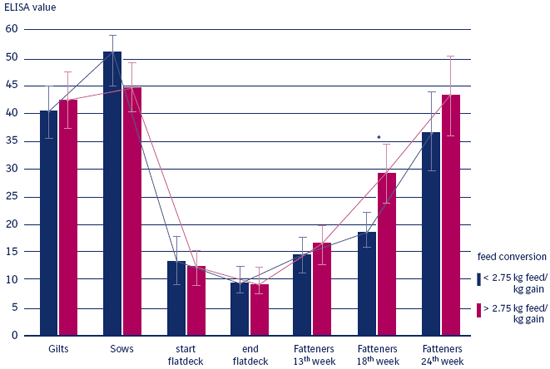2.1.7 Are there differences in the ELISA profiles in farms with good compared to poor feed conversion in fattening?
It is well established that pigs suffering from Ileitis have to eat more feed per kg gain and have higher feed costs than healthy pigs (Gebhart and McOrist 1999). This leads to the obvious question whether differences in the feed conversion can be mirrored in the Ileitis seroprofile (Fig. 2.1.7a).

Figure 2.1.7a
Ileitis ELISA values in farms with good feed conversion (<2.75g feed per kg gain) compared to farms with poor feed conversion (>2.75 kg feed per kg gain) in fattening.
* means with non overlapping 0.95 confidence intervals are significantly different.
Farms with poor feed conversion showed significantly higher Ileitis ELISA values in the fattening period than farms with good feed conversion. Jacobson et al. (2003) came to the same conclusion by comparing a wide range of enteric pathogens in good and poor performing herds. In addition to L. intracellularis being the most common cause of infectious enteric disease in growing pigs, there was a significant correlation between poor performance and the presence of L. intracellularis and B. pilosicoli.
The overall figure is remarkable because it identifies infections with L. intracellularis as a major influencing factor for lower feed conversion and higher feed costs across European farms.
There are many open questions concerning the epidemiology of L. intracellularis infections in European farms. Within the factors which both influence the time of infection and the econo-mic impact of Ileitis, the phasing out the few remaining antimicrobials used as feed additives in the EC in January 2006 is of major concern (EC regulation 1831, 2003).
© Boehringer Ingelheim Animal Health GmbH, 2006
All rights reserved. No part of this Technical Manual 3.0 may be reproduced or transmitted in any form or by any means, electronic or photocopy, without permission in writing from Boehringer Ingelheim Animal Health GmbH.






